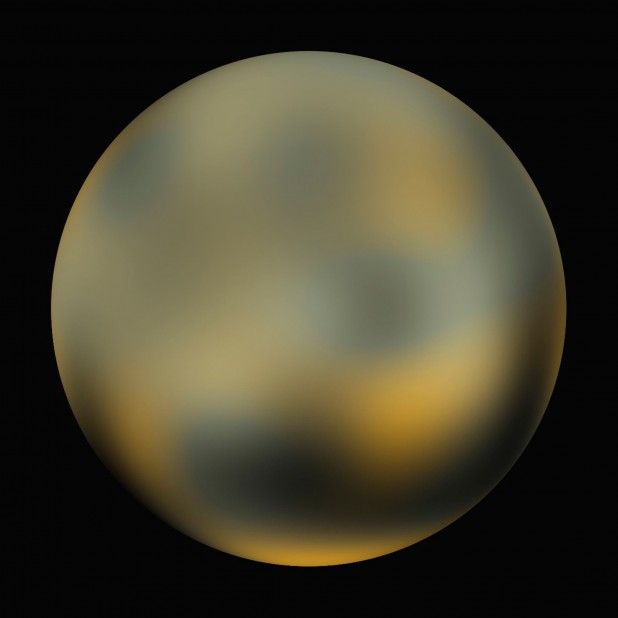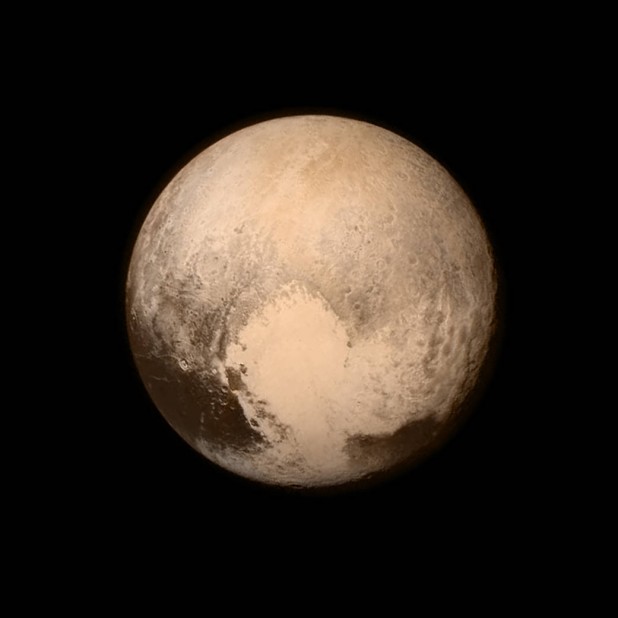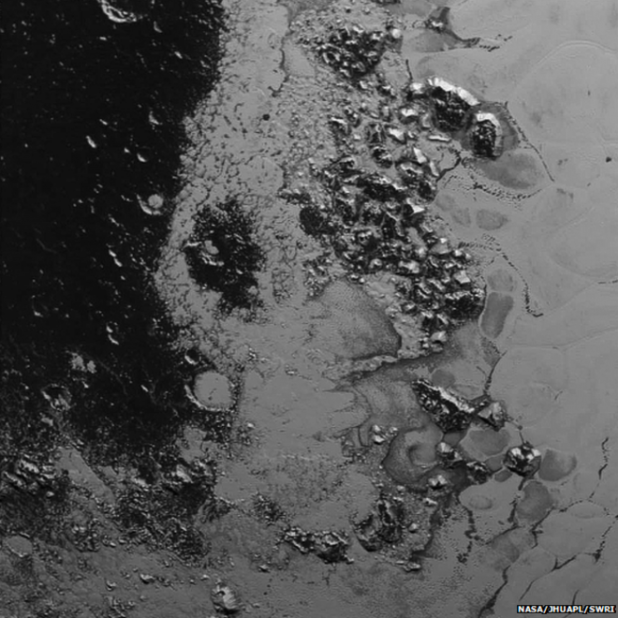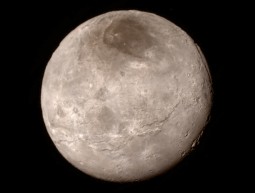A distant image of Pluto taken from the Hubble telescope
Pluto Unveiled
On the 14th of July a space probe cut inside the orbit of the moon Charon and travelling close to 50,000 km per hour, screamed by the dwarf planet Pluto. After journeying for nine years New Horizons took just three short minutes to skim across the world’s surface before it sped on, outward into the distant reaches of the solar system. Back on Earth a decade old row flared back to life. At its core lay one question, is Pluto a planet?
For more than half a century now mankind has been exploring our solar system. Landers have touched the surface of distant worlds, space probes whizzed past the great gas giants and as you read this robots rovers are trekking across the sands of the planet Mars. In all this there remained one yawning gap, a last piece of the jigsaw waiting to be filled. Pluto, a small distant world circles our Sun some seven and a half billion km from Earth. Last of the original nine planets, it remained little more than an unknown blurry dot of light.
Over the decades, as each probe and robot explorer blasted into space, our knowledge of the solar system grew. We now know that the rings of the planet Saturn are made of little rocks of ice and that an ocean of water lies beneath the surface of the moon Europa. But what we knew of Pluto could barely fill half a page. It remained far out at the edge of interstellar space, beyond the ability of earth bound telescopes to make out anything but the vaguest of details.
Pluto’s eccentric orbit
We knew it to be small (now confirmed at 2370 km across), that it had its own Moon called Charon and in time we learned that it had four smaller moons, Nix, Hydra, Styx and Kerberos. Above all we knew it to be an odd little world that didn’t quite fit in with its brother planets. Something was always just that little bit off about Pluto.
There’s a pattern to our solar system. Our own Earth is one of four rocky worlds that orbit closest to the Sun. Further out lie the great gas giants, huge planets circled by many moons, some of which are worlds in their own right. Then there’s Pluto. A small rocky planet with a surface area the size of Russia that patrols the distant edge of our solar system, it’s the wrong size and it’s in the wrong place.
Its eccentric nature didn’t end there. The other eight planets circle our Sun on a plane that’s as flat as a table top. Pluto is a renegade. It’s inclined at 17 degrees; sometimes it’s higher than the planetary plane, sometimes lower.
Not satisfied with just being a little bit different Pluto has to go one step further. The planets all revolve in nice neat mathematically pleasing circles. But Pluto has an elliptical, oval shaped orbit, almost as if it’s revolving around it’s very its own sun. This means that for most of its year (one Pluto year is 248 earth years) it’s the ninth and last planet but for long stretches it slip’s back inside the orbit of the great ice giant Neptune and drops back to number eight. Pluto just does its own thing.
From the off there were doubts about Pluto, but first man to really question its planetary status was Irish astronomer Kenneth Edgeworth. Back in 1938 the Westmeath man theorised that Pluto was part of a third zone, one member of a disk of icy bodies left over from the birth of the Solar system. It was a belief that was later shared by the Dutch-American astronomer Gerard Kuiper. Originally this region became referred to as the Edgeworth- Kuiper belt before eventually being shortened to the Kuiper belt.
Edgeworth’s theory was all well and fine but without proof that’s all it remained, a theory and since its discovery the wider astronomical community seemed happy to give Pluto the benefit of the doubt. And for many decades that’s how it remained, a distant unvisited relative that could be safely left, parked at the back of the mind.
In the nineties this was to change, telescopes started to pick up distant objects and questions started to be asked. Some of these bodies such as Makemake and Haumee turned out to be big, and one of these new worlds, Eris, had a mass greater than Pluto itself. The Kuiper belt was no longer a theory.
Here lay a fork in the road, either accept these new comers as planets in their own right or else redefine what a planet is in such a way as to banish Pluto and its distant brethren from the planetary fold. The problem rested with the question, what makes a planet a planet?
In 2006 the International Astronomical Union met and decided to “demote” Pluto from being a planet to a new class of celestial body known as a dwarf planet. In order to do this the union came up with three rules for what makes a planet a planet.
A planet has to circle the Sun, it has to be round in shape and it has to have cleared its own neighbourhood of other objects. Pluto rotates amongst a band of icy rocks that make up the Kuiper belt and was never going to pass the last part of the test. We were back to having eight planets in the solar System. Pluto was out of the club.
Pluto with its heart shaped great plain
People are loyal this far away world. Its distance, diminutive size and sheer oddness make it feel like a wayward little brother wandering out in the dark. Originally Pluto was named after the Roman God of the dead and ruler of the underworld; however the advent of Walt Disney meant that today that name is more likely to evoke a cartoon dog. The demotion was to have a ‘who killed Bambi’ like effect, a picking on the little guy or even an assassination. Emotions ran high; members of the Astronomical union were branded Pluto killers.
Many on New Horizons project team were particularly aggrieved and on the face of it it’s easy to see why. When launched the probe strode forth to explore the last planet, but within a few months Pluto got the heave ho, and the team found they were involved in something lesser. After all, one line of reasoning went, what was a dwarf planet but a planet that could not make the cut?
The ice mountains of Pluto
As the probe awoke from hibernation, and its long range camera brought this distant world into view the old row flared up again. Arguments and insults have traded back and forth across the internet. In one sense the planet versus dwarf debate is immaterial. Pluto does not care what we call it, it is as it is, and what it is something special.
As each day passed and the distance between probe and its target closed, Pluto came into view. What at first appeared as a fuzzy speck became a tiny disk, which over time turned into a ball. Day by day fresh details emerged and from out of the dark a new world appeared.
Pluto is a pinkish red world with a thin nitrogen atmosphere that reaches far above its home planet out in to space and may even envelope it’s moon Charon giving it a strange dark polar cap. The two appear to be a binary system, two bodies that dance close together, circling a common point, both worlds in their own right.
Charon with its dark polar cap.
Both Charon and its mother planet appear geologically active. Pluto has a mountain range as high as the Rockies cut from ice as hard as rock and a great frozen plain with features so strange they question are understanding of geology; Charon has cliffs and troughs that stretch for a thousand km stretch across its equator and a mighty chasm as much as nine km deep, longer and deeper then the Earths grand Canyon.
New Horizons is now so distant and has gathered so much information in its hurried high speed flyby that close to a year and a half will have passed before its finished downloading all it has learned. The door to our understanding has not been kicked in but will, over the course that time, gentle swing open. In the coming months we will be unwrapping reams of data and no doubt stunning imagery and gradually building a picture of what is clearly a strange and exotic place.
By the time the last piece kilo-bit of that information has streamed back home to Earth New Horizon’s will have journeyed on, deep into the Kuiper Belt and we will have been gifted not a dwarf or a planet but all the knowledge of what is to us, a brand new world.













